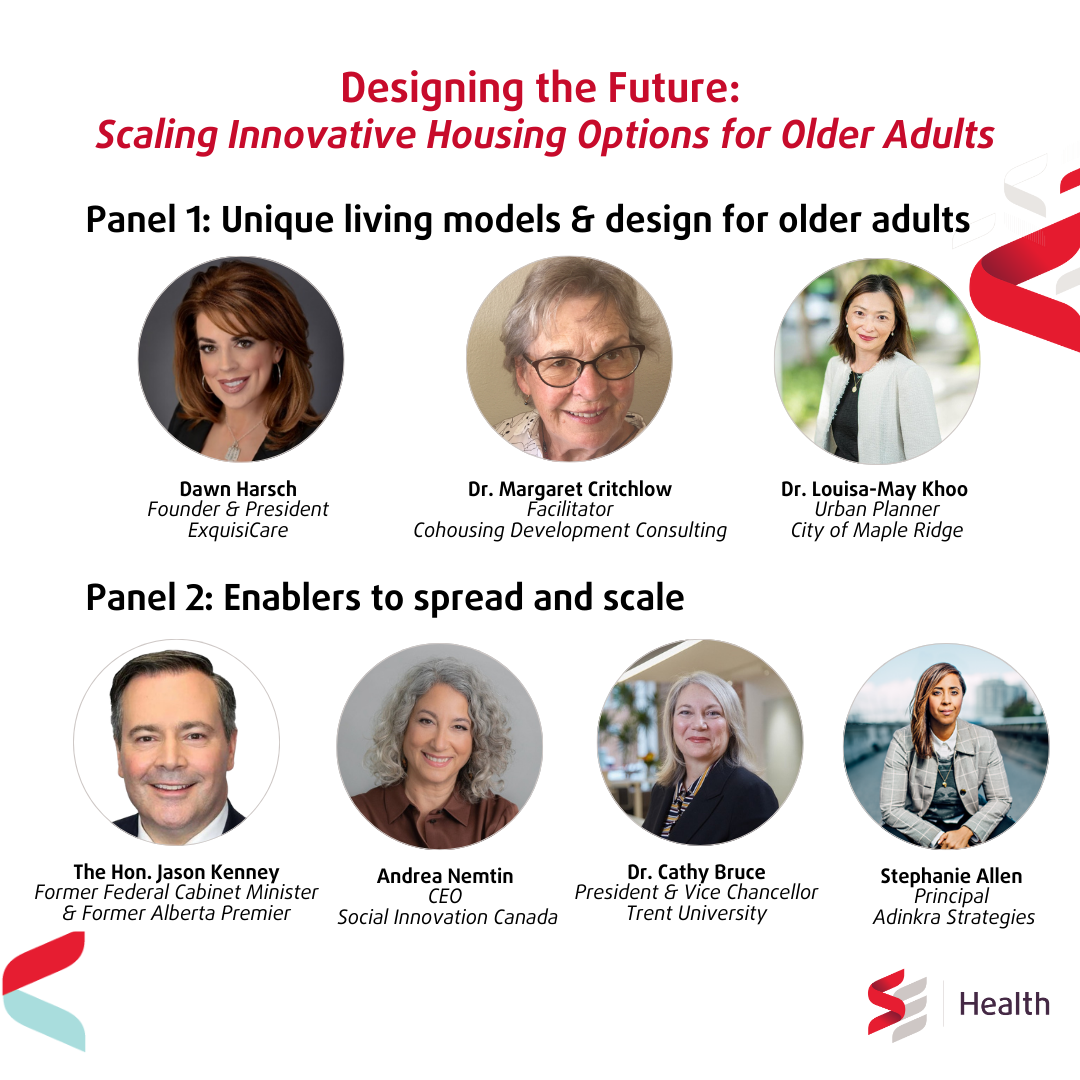How do you spread and scale innovative housing options for older adults across Canada? At our event, Designing the Future: Spreading and Scaling Innovative Seniors Living Models, we tackled just that.
We brought together healthcare and housing organizations, developers, funders, planners, advocates and government officials to hear from our inspiring panelists who are shaping the future of housing for older adults.

A range of innovative housing models are emerging worldwide, offering alternatives to traditional models, blending affordability, care, and community. This allows for solutions to meet different needs.
“…it's just about choice – I think everybody needs to advocate for wanting the ability to have that choice.” - Dawn Harsch, President and Founder of ExquisiCare
Longevity Models in Singapore
Developed by the Singaporean government,
Community Care Apartments provide age-friendly housing with flexible, scalable care services and social activities.
Cohousing
Residents maintain private homes while sharing common spaces to encourage social interaction, and community-building. For example:
Harbourside Cohousing and
Community Harbour Co-Housing.
Small Care Homes
Small care homes, like
ExquisiCare (a subsidiary company of SE Health), provide personalized, home-like long-term care. ExquisiCare features residential-style homes with 10-12 residents and 24/7 care.
Trent University-Integrated Seniors Village
Trent University is addressing the long waitlist for care for older adults in Peterborough through their
University-Integrated Seniors Village. It’s anchored by a long-term care home and supported by the expertise of the
Trent Centre for Aging & Society.
“This is not just about housing. It's about how to save the healthcare system.” - Hon. Jason Kenney, Former Federal Cabinet Minister and Former Alberta Premier
As the global population ages, it’s crucial to rethink how we approach aging and housing. Experts are advocating for a shift in how we plan and design communities to better support older adults.
Integrate Aging into Policymaking
Rather than be treated as an afterthought, aging needs to be embedded in governance and city planning. In Singapore, aging has shifted from being a “private responsibility” to a societal issue, resulting in policy changes that improved care for older adults.
Enable Models that Value Community-Building
Promoting models that emphasize community-building will lead to better outcomes. Models like ExquisiCare integrate families into the care, fostering meaningful relationships among residents, staff, and visitors. Intergenerational classrooms at Trent University strengthen ties between older adults and students, while cohousing communities encourage interaction through shared spaces.
The housing crisis simply cannot be solved in silos. Pairing those with the expertise and resources is crucial. That’s why thinking outside-of-the-box in partnerships is critical for creating sustainable housing solutions for older adults.
“Evolution can also happen at the community and project level, where strong partnerships and collaboration are vital.” - Stephanie Allen, Principal of Adinkra Strategies
Public-Private-Partnerships
This type of partnership brings in government and the private sector and allows stable funding and efficient housing expansion. Alberta’s Continuing Care Capital Program is one such example, combining government capital grants with private and non-profit operations.
Community Integration
Cohousing models promote shared spaces and decision-making among residents, while small care homes embrace neighbourhood integration. To support models like these, municipalities can provide land, subsidies, and flexible planning.
Current funding structures don’t always meet the needs of smaller, innovative projects and require more creative financing approaches.
Non-Market Models
In cohousing, residents contribute at least 25% of the project development cost to secure credit union financing. With smaller units and shared spaces, cohousing unlocks some level of affordability.
Funding Innovation in Alberta
New funding models are helping scale innovative housing solutions. Alberta’s Continuing Care Capital Program provides flexible funding to modernize care spaces for older adults, supporting private, charitable, and nonprofit providers. These partnerships highlight the benefits of involving diverse organizations.
The time for talk is over—bold action is needed. Governments, communities, and individuals all have a role to play in shaping the future of housing for older adults, and there are actions you can take today.
“You really need to be bold in testing out new models, testing out policies and regulatory measures that can help.” - Dr. Louisa-May Khoo, Urban Planner
Policy Changes
Governments can simplify zoning, fast-track approvals, lower development charges, and support funding models for diverse older adult housing. They must also ensure funding stability beyond election cycles to move beyond pilot programs.
Grassroots advocacy
Individuals and communities can push for policy reforms, advocate for needs-aligned housing and co-design new housing solutions. For example, cohousing communities begin with like-minded individuals creating affordability and autonomy through resident-led decision-making.
Individual steps
Anyone (like you!) can get involved in designing the future of innovative housing models for older adults.
Here are a few concrete ideas:
- Raise awareness by bringing the topics of aging and housing to the tables and communities you are part of.
- Connect with innovative housing providers to learn more and identify ways to support or advocate for projects.
- Strengthen the sector by investing in or lending your expertise to new housing projects or advancing new financial models.
For more information, check out Building with Mission:
The Role Healthcare Organizations Can Play
A Vision for the Future
“The future is going to be values driven, community accountable, [and] cooperative.” - Stephanie Allen, Principal of Adinkra Strategies
Planning for longevity in a super-aged society (countries with more than 20% of the population being over age 65) must be integrated into governance and civic planning. The goal is to create a world where everyone feels loved in their homes, which requires reimagining the housing supply chain. Financing and supporting community-focused models are essential to achieving this vision
A bold transformation is needed to unlock real progress and drive lasting change.
Curious to learn more?
Dive into the full event recording below and take a look at
Housing Event Resources and Recording to discover our event panelists and resources.